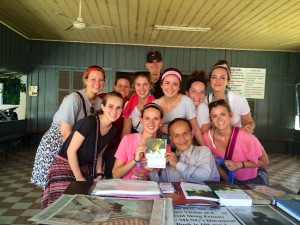 Mission to Cambodia 2014
Mission to Cambodia 2014
from Libby Franck, Nursing student
Today, we all went as a Group to the Asia School to teach. I had the privilege of watching the other students in our group teach as I took notes along with the Cambodian students. It was a great experience, not only to learn what I have not yet learned in school, but also to see how eager the Cambodians are to learn their practice.  Though what we were teaching them were all fairly basic concepts to us (like hand washing and how to assess and report a patients condition) to them these concepts were less understood. The way they were engaged and asked questions was really great to watch because I could see the impact of what we were teaching.
Though what we were teaching them were all fairly basic concepts to us (like hand washing and how to assess and report a patients condition) to them these concepts were less understood. The way they were engaged and asked questions was really great to watch because I could see the impact of what we were teaching.
After teaching all morning and having lunch, we had some down time. A group of us decided to go to the Russian Market for a bit (It is not actually Russian) to experience the culture of this beautiful city even more. Continue reading


